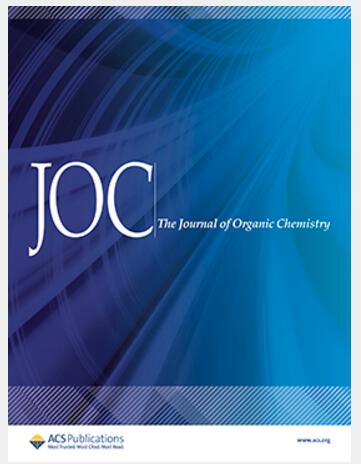Cross-Dimerization Giving Silyl-Substituted Conjugated Hexatrienes: An Approach to 1,6-Diarylhexa-1,3,5-trienes
IF 3.3
2区 化学
Q1 CHEMISTRY, ORGANIC
引用次数: 0
Abstract
A new approach to 1,6-diarylhexa-1,3,5-trienes (DAHs) has been achieved. Cross-dimerization of 1-aryl-2-silylethyne (1) with benzyl((E)-buta-1,3-dien-1-yl)dimethylsilane (2c) catalyzed by [Ru(η6-naphthalene)(η4-1,5-cycloocatdiene)] produces (1E,3E)-(6-aryl-5-silylhexa-1,3,5-trien-1-yl)benzyl(dimethyl)silane (3), where the dominant stereochemistry at the 5-position in 3 is the E-form. Subsequent Hiyama cross-coupling of 3 with aryl iodide catalyzed by [Pd2(dibenzylideneacetone)3]·C6H6 in the presence of TBAF·3H2O gives a series of (1E,3E,5E)-1,6-diarylhexa-1,3,5-trienes (DAH), showing that the C(5)═C(6) double bond rotates in the event of protodesilylation. The controlled experiments suggest that the Hiyama cross-coupling of the terminal silyl group in 3 takes place first, and then protodesilylation of the internal silyl group occurs to give (1E,3E,5E)-DAHs. An X-ray structure analysis reveals the molecular structure of (1E,3E,5E)-1-(4-acetylphenyl)-6-phenylhexa-1,3,5-triene. The photochemical study of some new DAHs has been conducted, showing bright fluorescence upon irradiation with a large Stokes shift (∼4026 cm–1) by π–π* transition according to TD-DFT calculations.

交叉二聚化生成硅基取代共轭六烯:1,6-二烷基六烯-1,3,5-三烯的方法
提出了一种合成1,6-二芳基己-1,3,5-三烯(DAHs)的新方法。由[Ru(η - 6-萘)(η - 4,1 -5-环catdiene)]催化的1-芳基-2-硅乙烷(1)与苄基((E)-丁基-1,3-二烯-1-基)二甲基硅烷(2c)的交叉二聚化反应生成(1E,3E)-(6-芳基-5-硅己-1,3,5-三烯-1-基)苄基(二甲基)硅烷(3),其中3中5位的主要立体化学为E型。随后在TBAF·3H2O存在下,由[Pd2(二苄基丙酮)3]·C6H6催化的3与碘化芳基进行Hiyama交叉偶联得到一系列(1E,3E,5E)-1,6-二芳基六烯-1,3,5-三烯(DAH),表明C(5) C(6)双键在原脱硅化反应中旋转。对照实验表明,3的末端硅基首先发生Hiyama交叉偶联,然后内部硅基发生原脱硅化反应,得到(1E,3E,5E)-DAHs。x射线结构分析揭示了(1E,3E,5E)-1-(4-乙酰苯基)-6-苯己-1,3,5-三烯的分子结构。对一些新的DAHs进行了光化学研究,根据TD-DFT计算,在π -π *跃迁的大Stokes位移(~ 4026 cm-1)照射下显示出明亮的荧光。
本文章由计算机程序翻译,如有差异,请以英文原文为准。
求助全文
约1分钟内获得全文
求助全文
来源期刊

Journal of Organic Chemistry
化学-有机化学
CiteScore
6.20
自引率
11.10%
发文量
1467
审稿时长
2 months
期刊介绍:
Journal of Organic Chemistry welcomes original contributions of fundamental research in all branches of the theory and practice of organic chemistry. In selecting manuscripts for publication, the editors place emphasis on the quality and novelty of the work, as well as the breadth of interest to the organic chemistry community.
 求助内容:
求助内容: 应助结果提醒方式:
应助结果提醒方式:


